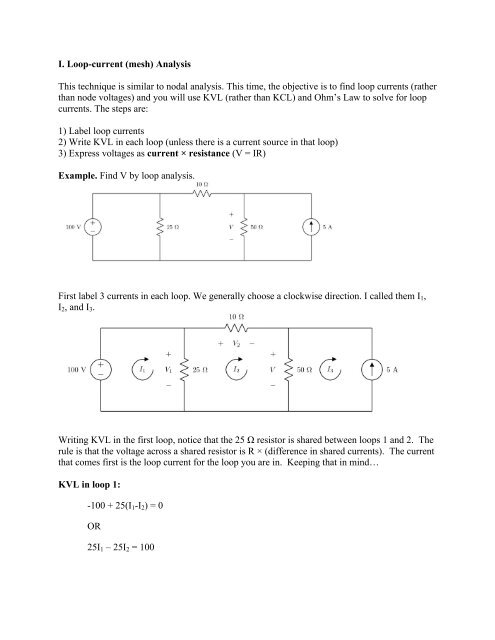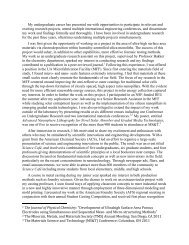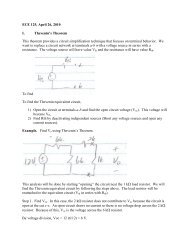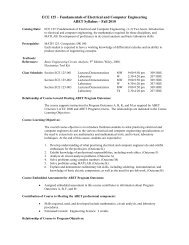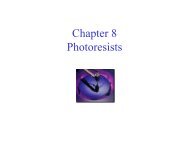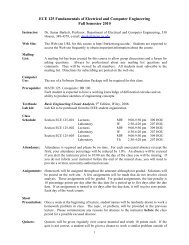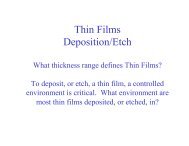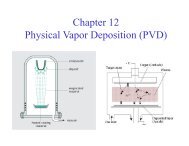I. Loop-current (mesh) Analysis This technique is similar to nodal ...
I. Loop-current (mesh) Analysis This technique is similar to nodal ...
I. Loop-current (mesh) Analysis This technique is similar to nodal ...
Create successful ePaper yourself
Turn your PDF publications into a flip-book with our unique Google optimized e-Paper software.
I. <strong>Loop</strong>-<strong>current</strong> (<strong>mesh</strong>) <strong>Analys<strong>is</strong></strong><br />
<strong>Th<strong>is</strong></strong> <strong>technique</strong> <strong>is</strong> <strong>similar</strong> <strong>to</strong> <strong>nodal</strong> analys<strong>is</strong>. <strong>Th<strong>is</strong></strong> time, the objective <strong>is</strong> <strong>to</strong> find loop <strong>current</strong>s (rather<br />
than node voltages) and you will use KVL (rather than KCL) and Ohm’s Law <strong>to</strong> solve for loop<br />
<strong>current</strong>s. The steps are:<br />
1) Label loop <strong>current</strong>s<br />
2) Write KVL in each loop (unless there <strong>is</strong> a <strong>current</strong> source in that loop)<br />
3) Express voltages as <strong>current</strong> × res<strong>is</strong>tance (V = IR)<br />
Example. Find V by loop analys<strong>is</strong>.<br />
First label 3 <strong>current</strong>s in each loop. We generally choose a clockw<strong>is</strong>e direction. I called them I 1 ,<br />
I 2 , and I 3 .<br />
Writing KVL in the first loop, notice that the 25 Ω res<strong>is</strong><strong>to</strong>r <strong>is</strong> shared between loops 1 and 2. The<br />
rule <strong>is</strong> that the voltage across a shared res<strong>is</strong><strong>to</strong>r <strong>is</strong> R × (difference in shared <strong>current</strong>s). The <strong>current</strong><br />
that comes first <strong>is</strong> the loop <strong>current</strong> for the loop you are in. Keeping that in mind…<br />
KVL in loop 1:<br />
-100 + 25(I 1 -I 2 ) = 0<br />
OR<br />
25I 1 – 25I 2 = 100
KVL in loop 2:<br />
25 (I2 – I1) + 10I2 + 50 (I2 – I3) = 0<br />
*Here note 2 things:<br />
Simplify th<strong>is</strong> equation<br />
a) I 2 comes first th<strong>is</strong> time because I am in loop 2<br />
b) For the 10 Ω res<strong>is</strong><strong>to</strong>r, the voltage <strong>is</strong> simply 10× I 2 because the 10 Ω res<strong>is</strong><strong>to</strong>r <strong>is</strong><br />
not shared between 2 loops.<br />
-25I 1 + 85I 2 – 50I 3 = 0<br />
In <strong>Loop</strong> 3 you have a <strong>current</strong> source so you already know I 3 . I 3 <strong>is</strong> flowing in a direction opposite<br />
<strong>to</strong> the <strong>current</strong> source so I 3 = -5 A. No need <strong>to</strong> write KVL.<br />
Substitute I 3 = -5 A in<strong>to</strong> the equation above.<br />
-25I 1 + 85I 2 = 50(-5)<br />
-25I 1 + 85I 2 = -250<br />
Now go back <strong>to</strong> the equation from loop 1,<br />
25I 1 – 25I 2 = 100<br />
Solve for I1 and I2<br />
60I 2 = -150 or I 2 = -5/2 = -2.5 A.<br />
Substitute that in and 25I 1 – 25(-2.5) = 100 or 25I 1 = 100-62.5 or I 1 = 1.5 A.<br />
In th<strong>is</strong> problem you were asked <strong>to</strong> solve for V, the voltage across the 50 Ω res<strong>is</strong><strong>to</strong>r (a res<strong>is</strong><strong>to</strong>r<br />
shared between loops 2 and 3). You need an expression for V that involves a difference in<br />
<strong>current</strong>s × 50 and th<strong>is</strong> time the <strong>current</strong> that comes first will be the one that sat<strong>is</strong>fies the passive<br />
sign convention. The <strong>current</strong> entering the positive terminal of the res<strong>is</strong><strong>to</strong>r <strong>is</strong> I 2 so I 2 comes first.<br />
V = 50(I 2 – I 3 ) = 50 × (-2.5 – (-5)) = 50 × 2.5 = + 125 V.
II.<br />
More examples of <strong>Loop</strong> <strong>Analys<strong>is</strong></strong><br />
Find I 2<br />
Label <strong>current</strong>s I 0 and I 1 (<strong>Th<strong>is</strong></strong> time I purposely did not name either of the loop <strong>current</strong>s I 2 because<br />
that <strong>is</strong> the <strong>current</strong> I am trying <strong>to</strong> find flowing up the middle branch).<br />
KVL in loop 1: 8I 0 + 2 I 0 + 2(I 0 – I 1 ) + 24 = 0<br />
12I 0 – 2I 1 = -24<br />
KVL in loop 2: -24 + 2(I 1 – I 0 ) + 4I 1 + 12 = 0<br />
-2I 0 + 6I 1 = 12<br />
Solve for loop <strong>current</strong>s. I 1 = 48/34 = 1.412 A and I 0 = -1.76 A. However, you are looking for I 2<br />
and I 2 = I 1 – I 2 because it <strong>is</strong> a <strong>current</strong> flowing in a branch shared by the two loops.<br />
I 2 = I 1 – I 2 = 1.412 – (-1.76) = 3.177 A.
Here <strong>is</strong> an example where a <strong>current</strong> source <strong>is</strong> present between two loops. In that case, the<br />
difference in the two loop <strong>current</strong>s <strong>is</strong> known. However when KVL <strong>is</strong> written in the two loops,<br />
you can not express the voltage as <strong>current</strong> × res<strong>is</strong>tance. In th<strong>is</strong> case, KVL <strong>is</strong> written around the<br />
entire loop. Go back <strong>to</strong> the <strong>current</strong> source for an equation involving the source.<br />
Example. Find V R by loop analys<strong>is</strong>.<br />
Label loop <strong>current</strong>s, I 1 and I 2<br />
Note that the difference between loop <strong>current</strong>s = 4 A. The one that comes first <strong>is</strong> the one flowing<br />
in the direction of the <strong>current</strong> source so<br />
I 2 – I 1 = 4 A.<br />
Now write KVL in the outside loop (we are avoiding writing KVL around the <strong>current</strong> source<br />
even though there <strong>is</strong> a voltage across it).<br />
-12 + 4 I 1 – 2 + 2I 2 = 0<br />
4 I 1 + 2I 2 = 14<br />
Now you have 2 equations, 2 unknowns<br />
Solve for I 1 , I 2<br />
I 1 = 1 A and I 2 = 5 A. In that case, V R = 2I 2 = 2(5) = 10 V.<br />
If you were also asked for the power associated with the 12 V source, you would find that by<br />
multiplying the voltage by <strong>current</strong> or 12 (I 1 ) = 12(1) = 12 W.<br />
What <strong>is</strong> the voltage across the 4A source (V CS ) Once you know the voltage across the 4 Ω<br />
res<strong>is</strong><strong>to</strong>r (4I 1 ) or 4Ω(1A) = 4V you can write KVL in the inner loop: -12 + 4 +V CS = 0 so<br />
V CS = 8V.


